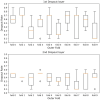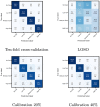Multi-Input CNN-LSTM deep learning model for fear level classification based on EEG and peripheral physiological signals
- PMID: 37325747
- PMCID: PMC10267388
- DOI: 10.3389/fpsyg.2023.1141801
Multi-Input CNN-LSTM deep learning model for fear level classification based on EEG and peripheral physiological signals
Abstract
Objective and accurate classification of fear levels is a socially important task that contributes to developing treatments for Anxiety Disorder, Obsessive-compulsive Disorder, Post-Traumatic Stress Disorder (PTSD), and Phobia. This study examines a deep learning model to automatically estimate human fear levels with high accuracy using multichannel EEG signals and multimodal peripheral physiological signals in the DEAP dataset. The Multi-Input CNN-LSTM classification model combining Convolutional Neural Network (CNN) and Long Sort-Term Memory (LSTM) estimated four fear levels with an accuracy of 98.79% and an F1 score of 99.01% in a 10-fold cross-validation. This study contributes to the following; (1) to present the possibility of recognizing fear emotion with high accuracy using a deep learning model from physiological signals without arbitrary feature extraction or feature selection, (2) to investigate effective deep learning model structures for high-accuracy fear recognition and to propose Multi-Input CNN-LSTM, and (3) to examine the model's tolerance to individual differences in physiological signals and the possibility of improving accuracy through additional learning.
Keywords: Convolutional Neural Network; EEG; emotion recognition; fear; long-term and short-term memory; physiological signal.
Copyright © 2023 Masuda and Yairi.
Conflict of interest statement
The authors declare that the research was conducted in the absence of any commercial or financial relationships that could be construed as a potential conflict of interest.
Figures






References
-
- Abadi M. K., Subramanian R., Kia S. M., Avesani P., Patras I., Sebe N. (2015). DECAF: MEG-based multimodal database for decoding affective physiological responses. IEEE Trans. Affect. Comput. 6, 209–222. doi: 10.1109/TAFFC.2015.2392932 - DOI
-
- Akiba T., Sano S., Yanase T., Ohta T., Koyama M. (2019). “Optuna: a next-generation hyperparameter optimization framework” in Proceedings of the 25th ACM SIGKDD international conference on knowledge discovery and data mining (KDD) (New York: Association for Computing Machinery; ), 2623–2631.
-
- Alhagry S., Fahmy A. A., El-Khoribi R. A. (2017). Emotion recognition based on EEG using LSTM recurrent neural network. Int. J. Adv. Comput. Sci. Appl. 8:10. doi: 10.14569/IJACSA.2017.081046 - DOI
-
- Altman N. S. (1992). An introduction to kernel and nearest-neighbor nonparametric regression. Am. Stat. 46, 175–185. doi: 10.2307/2685209 - DOI
LinkOut - more resources
Full Text Sources

